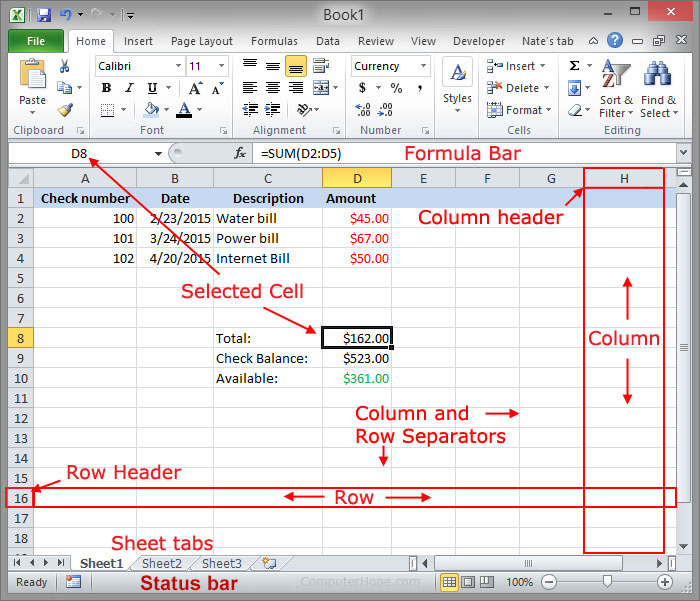Cell
A cell may refer to any of the following:
1. A cell is the intersection where a row and a column meet on a spreadsheet, starting with cell A1. In the following example, a highlighted cell D8 (column D, row 8) is shown in a Microsoft Excel spreadsheet. That designation (D8) is also known as the cell address or cell reference. Any modifications made while a cell is highlighted are limited to that specific cell in the worksheet.

Here, D8 is the active cell. In the formula bar, you can see that the cell content is =SUM(D2:D5). This formula evaluates the result of $162.00 by calculating the sum of the values stored in cells D2 through D5.
Each cell in a spreadsheet can contain any value that can be called using a relative cell reference or called upon using a formula.
How can you determine a cell reference?
When using the arrow keys or by clicking a cell to navigate a spreadsheet, the cell reference (cell address) is updated and shown in the upper-left corner. Also, the column and row headers are highlighted. In the picture above, you can see the "D" column, and the "8" row is highlighted in yellow. The cell reference is shown as the selected cell.
How do the rows and columns increase?
When you first open the spreadsheet, the active cell is always placed in the first column (column "A"). As you move to the right, the columns are increased by going through the English alphabet. So, pressing the right arrow key once moves the active cell into the "B" column, pressing the right arrow again moves the active cell into the "C" column, etc. When you get to the last letter of the alphabet ("Z"), the columns become two letters with the "AA" column, then "AB," "AC," etc. After getting to "AZ," the columns become "BA," "BB," "BC," etc. If you were to get to "ZZ," the next column would increase to three letters and start with "AAA," then "AAB," "AAC," etc.
Rows are increased numerically, starting with the first row of number "1." Pressing the down arrow key would increase the row to "2," and pressing it again would increase the row to "3."
See our spreadsheet definition for further information on using spreadsheets.
How to move between cells
To move between cells in a spreadsheet, click the cell you want to make active or use the arrow keys to move up, down, left, and right one value. You can also use the page up and page down keys to move one page at a time.
Other keyboard shortcuts
In addition to moving between cells using the arrow keys, you can also use the following keyboard shortcuts:
- F5 - The F5 function key lets you go to a specific cell. For example, you could press F5, type "n9" and press Enter to go to cell N9.
- Tab - Pressing Tab moves one cell to the right.
- Shift+Tab - Move one cell to the left.
- Home - Move to the first cell in the row.
- Ctrl+Home - Go to the first cell in the spreadsheet (A1).
- Ctrl+End - Go to the last cell with data in the worksheet.
2. Like a spreadsheet cell, a cell is a section in an HTML (hypertext markup language) table that is created using the HTML <td> tag. It is generally used as an area to display or compare related information and data sets.
3. Cell is another name for a cell phone.
4. A cell refers to a unit of data that is transferred over an ATM (asynchronous transfer mode) network.
5. Cell is the geographical area that a cell tower covers for cell phone reception. It is often measured in square miles and may overlap with another cell tower's cell.
Cel, Range, Relative cell reference, Row, Spreadsheet, Spreadsheet terms
